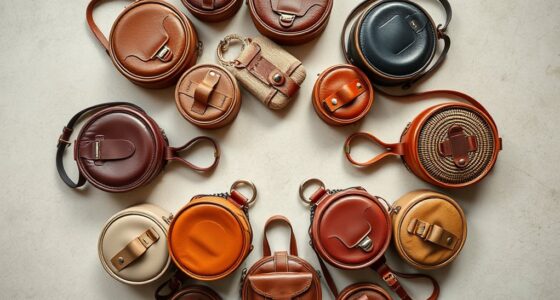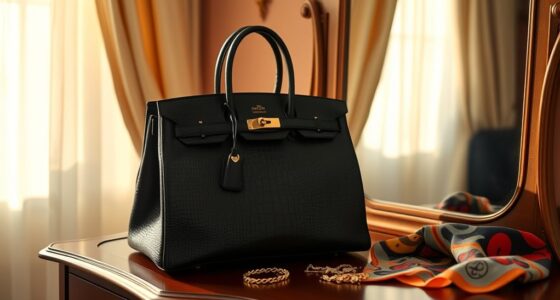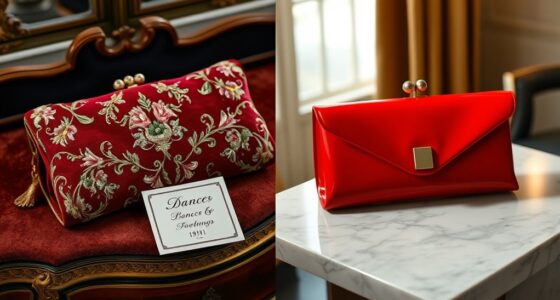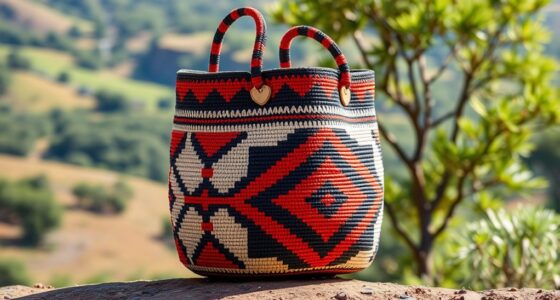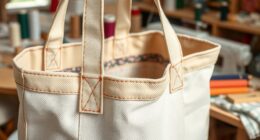Quilted bags have a long history, blending tradition, craftsmanship, and innovation. From ancient textile techniques used across cultures to Coco Chanel’s revolutionary 2.55, quilting became a symbol of luxury and elegance. Today, designers innovate with sustainable materials and modern tech, while vintage styles inspire a resurgence in fashion. If you explore further, you’ll uncover how these timeless accessories continue to evolve and influence contemporary design trends.
Key Takeaways
- Quilted fabrics have been used for centuries across various cultures for both functional and decorative purposes.
- The Chanel 2.55, designed in 1955, popularized quilted leather handbags with iconic diamond stitching and chain straps.
- Modern quilted bags incorporate technological innovations like laser quilting, sustainable materials, and smart textiles.
- Vintage quilted bags are experiencing a resurgence, blending traditional craftsmanship with contemporary style influences.
- Future trends focus on eco-friendly materials, digital customization, multifunctionality, and sustainable design practices.
The Origins of Quilted Craftsmanship
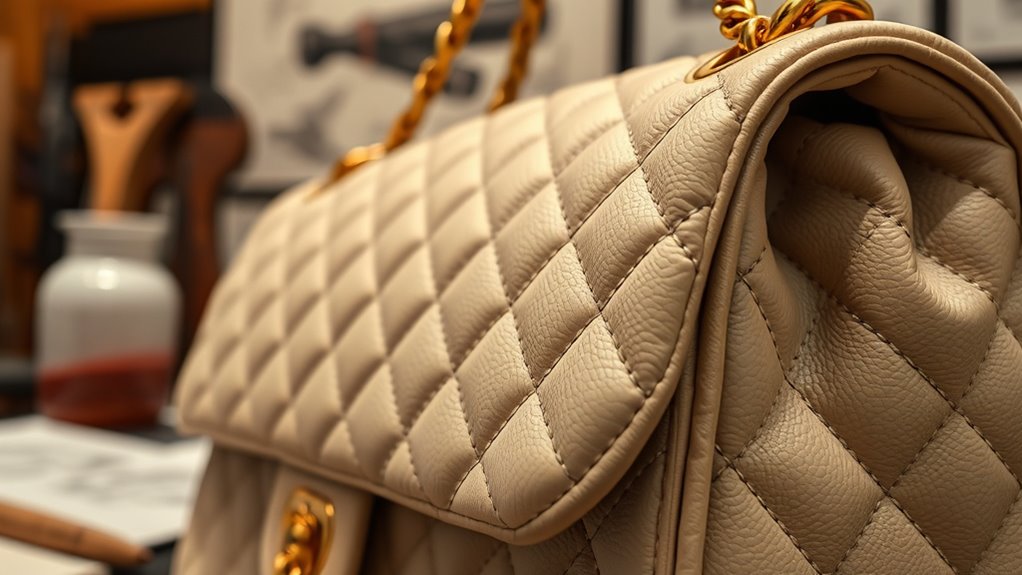
The origins of quilted craftsmanship date back centuries, with early examples appearing in different cultures around the world. You’ll find that these textile techniques served functional and decorative purposes, showcasing craftsmanship traditions passed down through generations. In ancient China, quilted fabrics were used for warmth and protection, while in Europe, quilting became an art form in quilting bees and elaborate bed covers. As you explore these historical pieces, you notice how skilled artisans combined stitches and padding to create durable, beautiful textiles. These craftsmanship traditions emphasized precision, patience, and creativity—traits still essential in quilting today. Additionally, the development of quilting techniques influenced the creation of home decor items, including the iconic quilted bags like Chanel 2.55. By understanding these origins, you gain insight into how quilting evolved from practical necessity to a revered art form that influences modern bag design.
Coco Chanel and the Birth of the Iconic 2.55
When Coco Chanel designed the 2.55 handbag in 1955, she revolutionized the way women carry their essentials by combining practicality with elegance. She used innovative textile techniques, like quilted leather, to create a textured, luxurious feel that became her signature. This handbag introduced a new level of luxury branding, emphasizing sophistication while remaining functional. The design featured a chain strap inspired by soldiers’ bags, making it hands-free and versatile. The 2.55’s structure reflected Chanel’s vision of modern femininity—simple yet stylish. Its timeless appeal lies in the perfect balance between craftsmanship and innovation. The handbag’s design elements, like the diamond quilting pattern, set a standard for quilted bags that endures today. Additionally, the use of vintage-inspired details contributes to its enduring charm and iconic status.
The Significance of Quilting in Fashion History

Coco Chanel’s innovative use of quilting in her handbag designs highlighted how textile techniques can elevate fashion into an art form. Quilted embroidery became more than decorative; it carried textile symbolism that conveyed luxury, comfort, and craftsmanship. This technique transformed simple fabrics into textured statements that reflected social status and artistic expression. The significance of quilting in fashion history lies in its ability to merge function with beauty, making accessories both practical and stylish. It also allowed designers to experiment with textile symbolism, imbuing pieces with deeper meaning. Additionally, quilting’s visual texture and durability contributed to its enduring appeal in fashion design. As a result, quilting became a symbol of elegance and innovation, influencing countless designs across decades. You see it not just as a technique but as a powerful way to communicate style, identity, and cultural values in fashion.
The Evolution of Quilted Bag Designs Through the Decades
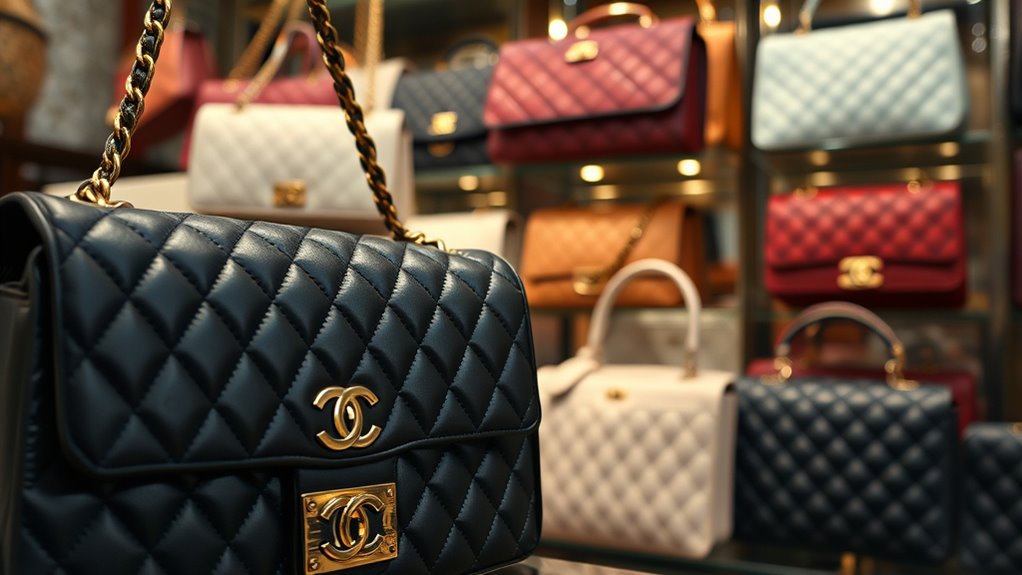
Throughout the decades, quilted bag designs have continuously evolved, reflecting changing fashion trends and technological innovations. You can see how quilted craftsmanship has adapted, blending traditional techniques with modern materials. In the 1950s, bags became more structured, emphasizing clean lines and luxury. The 1970s introduced bold, oversized quilting patterns, mirroring the era’s experimental style. During the 1990s, minimalism took hold, with sleek, understated quilted designs gaining popularity. Today, innovations like lightweight textiles and eco-friendly materials shape contemporary styles. You’ll notice these key developments:
Quilted bag styles evolved from structured luxury to minimalist, eco-friendly designs across decades.
- Shift from structured to softer, more adaptable shapes
- Introduction of varied quilting patterns and textures
- Incorporation of new, sustainable materials
- Evolution of hardware and embellishments
- Fusion of classic craftsmanship with modern aesthetics
The influence of technological advancements has also played a significant role in how quilted bags are designed and produced today.
Influential Designers and Their Contributions to Quilted Style

Several designers have left an indelible mark on the evolution of quilted bags, blending tradition with innovation to shape modern styles. Coco Chanel pioneered the use of textile symbolism, transforming quilted leather into a symbol of elegance and sophistication. Her mastery of artisanal techniques, such as precise quilting and fine leatherwork, elevated the bag into a timeless accessory. Following her lead, contemporary designers like Karl Lagerfeld and others have expanded on these techniques, experimenting with materials and patterns while respecting the bag’s rich heritage. These designers have also infused their unique visions into quilted styles, ensuring this classic design remains relevant today. Their contributions demonstrate how a blend of textile symbolism and artisanal craftsmanship can redefine fashion, making quilted bags both iconic and adaptable across eras. Additionally, the influence of silky textiles and innovative manufacturing processes has allowed these bags to evolve while maintaining their traditional allure.
Quilted Bags in Popular Culture and Celebrity Fashion

You’ve probably seen quilted bags everywhere, thanks to celebrity endorsements and trending styles. These bags often make appearances in iconic film moments, cementing their status in pop culture. Their popularity continues to grow as stars and movies boost their fashionable appeal. Additionally, the timeless design of quilted bags has made them a fashion staple across decades, blending classic elegance with modern trends.
Celebrity Endorsements and Trends
Have you ever noticed how certain designer bags become instant iconography thanks to celebrity endorsements? Celebrity collaborations play a huge role in elevating quilted bags within luxury branding, making them must-have items. When stars are spotted carrying these bags, it sparks trend waves and boosts demand. Their influence extends beyond fashion icons to social media, where followers emulate their style choices. High-profile endorsements often lead to limited-edition releases, fueling exclusivity. Brands leverage these moments to craft a sense of luxury and desirability around quilted bags. Celebrity-driven trends keep quilted bags relevant, ensuring their place in contemporary fashion. This synergy between celebrities and designers continuously shapes the popularity of quilted bags in popular culture. The popularity of quilted bags is also reinforced by their association with iconic fashion accessories, which further cements their status in the luxury market.
Iconic Moments in Film
Iconic moments in film have played a significant role in cementing quilted bags as symbols of luxury and style. When you see a quilted craftsmanship detail on a scene’s handbag, it instantly evokes elegance and timelessness. Films like *Breakfast at Tiffany’s* showcase how these bags embody high fashion symbolism, elevating their status beyond mere accessories. The Chanel 2.55’s appearance in classic movies transformed it into a cultural icon, representing sophistication and glamour. Such moments influence trends and inspire celebrity endorsements, making quilted bags a must-have in fashion history. Their presence on screen continues to reinforce their place as symbols of luxury, ensuring their legacy endures in popular culture and celebrity fashion alike.
Modern Innovations and Materials in Quilted Bag Production

Modern innovations and materials have transformed quilted bag production, allowing designers to create more durable, lightweight, and versatile accessories. Technological advancements enable the use of sustainable materials, reducing environmental impact while maintaining quality. You’ll find innovative fabrics like recycled nylon, plant-based leathers, and biodegradable synthetics that support eco-conscious fashion. These materials improve durability and comfort without sacrificing style. Additionally, advanced manufacturing techniques, such as laser quilting and 3D printing, enhance precision and efficiency. The integration of smart textiles introduces functionalities like water resistance and temperature regulation. Overall, these innovations expand design possibilities and make quilted bags more practical and sustainable for today’s consumers.
Innovative materials and advanced techniques make quilted bags more durable, lightweight, eco-friendly, and multifunctional for modern consumers.
- Sustainable fabrics and eco-friendly dyes
- Recycled and biodegradable synthetics
- Laser-cut quilting techniques
- Smart textile integrations
- Lightweight, durable materials
The Resurgence of Vintage Quilted Bags in Contemporary Fashion

In recent years, vintage quilted bags have made a compelling comeback on runways and in street style, blending nostalgic charm with contemporary appeal. As fashion leans toward sustainability, designers and consumers are embracing vintage pieces made from sustainable fabrics, reducing environmental impact. These bags often showcase artisanal techniques, highlighting craftsmanship and unique detailing that mass-produced items lack. The revival is driven by a desire for authentic, timeless accessories that stand out amid fast fashion. You’ll notice a mix of classic quilting patterns with modern twists, making these bags versatile for everyday wear or special occasions. This resurgence not only celebrates heritage craftsmanship but also aligns with current eco-conscious trends, proving that vintage quilted bags remain relevant by combining tradition with modern values. Incorporating high-quality equipment and skilled techniques, artisans are able to create these distinctive pieces that resonate with today’s conscientious consumers.
How Quilted Bags Continue to Influence Modern Accessories
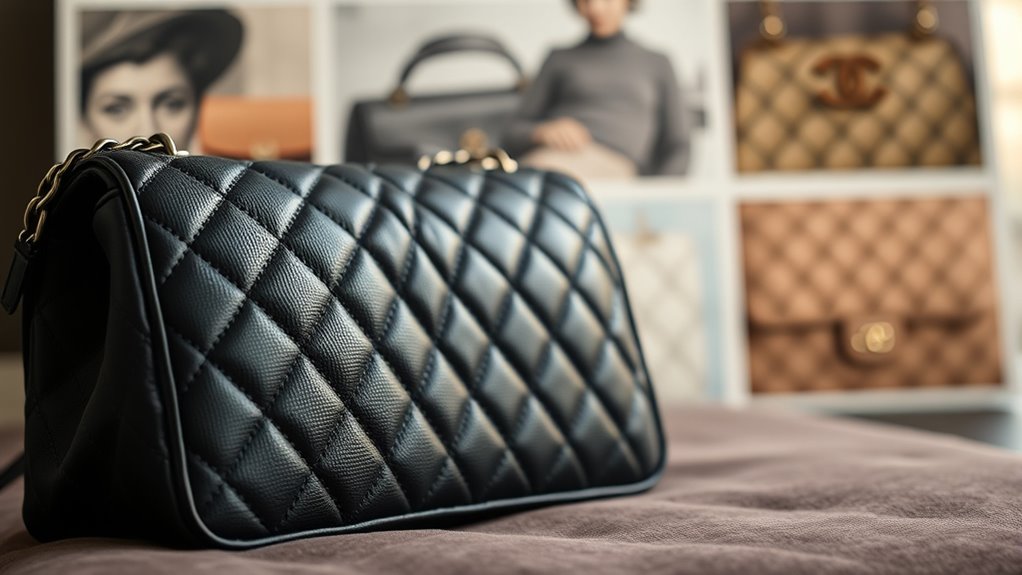
You can see how iconic design elements like diamond quilting still shape modern accessories, giving them a timeless appeal. Celebrity endorsements keep quilted bags in the spotlight, influencing current trends and styles. Plus, innovations in materials make these bags more durable and versatile, ensuring they stay relevant today. Embracing mindful design also encourages the use of sustainable and responsibly sourced materials, aligning fashion with environmental consciousness.
Iconic Design Elements
The quilted pattern has become a defining feature that instantly elevates the sophistication of accessories, and its influence is evident in many contemporary designs. You can see this in how modern brands incorporate quilted craftsmanship and textile techniques to create textures that evoke luxury and tradition. These iconic design elements continue to shape the aesthetic of handbags, wallets, and even apparel. Additionally, the use of textile techniques in quilting reflects a blend of traditional craftsmanship and innovative material application, further enhancing the appeal and durability of modern quilted accessories.
Celebrity Endorsements Influence
Celebrity endorsements have played a pivotal role in keeping quilted bags at the forefront of fashion trends. When icons like Rihanna or Kylie Jenner showcase these bags, their influence sparks renewed interest and style inspiration. Modern celebrities often highlight embroidery techniques and textile dyes, emphasizing craftsmanship and vibrant colors that enhance quilted designs. This visibility boosts their desirability, making quilted bags a staple in contemporary accessories.
| Celebrity | Influence on Trend |
|---|---|
| Rihanna | Popularizes bold embroidery |
| Kylie Jenner | Promotes colorful textile dyes |
| Zendaya | Champions craftsmanship |
| Harry Styles | Reinforces timeless appeal |
This dynamic endorsement cycle ensures quilted bags remain a symbol of luxury and innovation.
Modern Material Innovations
Modern material innovations have propelled quilted bags into the forefront of contemporary accessories, transforming their traditional designs with cutting-edge textiles and techniques. You now see designers experimenting with sustainable textiles, reducing environmental impact without sacrificing style. 3D embroidery adds texture and depth, making each bag unique and eye-catching. These innovations enable durability, flexibility, and eco-friendliness, appealing to modern consumers. You might notice:
- Use of recycled fabrics and biodegradable materials
- Incorporation of 3D embroidery for intricate detailing
- Lightweight, flexible composites for comfort
- Water-resistant sustainable textiles
- Advanced dyeing techniques for vibrant, eco-conscious colors
These advancements guarantee quilted bags remain relevant, stylish, and environmentally responsible in today’s fashion landscape.
The Future of Quilted Bag Design and Trends

As designers continue to innovate, quilted bags are poised to evolve with new materials, shapes, and functionalities that cater to changing consumer preferences. Expect sustainable practices to play a bigger role, with eco-friendly fabrics and ethical production methods becoming standard. Digital customization will also grow, allowing you to personalize designs easily online, enhancing your connection to the product. Future trends may include versatile shapes that transform for different occasions and integrated smart features for convenience. Here’s a glimpse of potential directions:
| Trend | Material Focus | Functionality |
|---|---|---|
| Eco-conscious design | Recycled fabrics | Modular, adaptable shapes |
| Personalization | Digital tools | Smart compartments & tech integration |
| Minimalism & Utility | Lightweight, durable materials | Multifunctional features |
Frequently Asked Questions
What Are the Traditional Techniques Used in Quilted Bag Craftsmanship?
You use traditional quilted bag techniques like embroidery techniques and fabric layering to create durable, stylish designs. Embroidery techniques add texture and elegance, while fabric layering involves stitching multiple fabric pieces together for durability and a plush feel. These methods require precision and skill, ensuring the quilted pattern stays intact and looks refined over time. Mastering these techniques results in a timeless, high-quality bag that stands out.
How Has Quilting Technology Evolved Over the Years?
Imagine quilting technology as a river that’s constantly flowing forward. You see, the quilted pattern evolution has been driven by stitching techniques advancements, making bags more durable and intricate. Modern innovations like machine stitching and high-quality materials have transformed traditional craftsmanship, allowing for finer, more precise quilting. Today, you benefit from these advancements, which blend timeless design with cutting-edge techniques, giving you stylish bags that stand the test of time.
What Materials Are Most Commonly Used Today for Quilted Bags?
You’ll find that today, most quilted bags use a variety of materials, including sustainable fabrics like recycled nylon and organic cotton, which help reduce environmental impact. Digital quilting technology also plays a role, allowing precise, intricate patterns that enhance durability and aesthetics. These innovations enable you to enjoy stylish, eco-friendly bags with modern craftsmanship, combining tradition with sustainability and advanced techniques for a versatile, contemporary look.
How Do Cultural Influences Shape Quilted Bag Styles Worldwide?
Imagine vibrant cultural symbols stitched into elegant quilted bags, blending tradition with fashion. Cultural influences shape styles by incorporating regional embroidery and symbolism, reflecting diverse identities worldwide. You see this fusion in patterns, colors, and motifs that honor local heritage, creating unique, meaningful accessories. These elements allow you to carry a piece of culture, transforming a quilted bag from simple design to a storytelling canvas rooted in cultural expression.
What Future Innovations Are Expected in Quilted Bag Design?
You can expect future quilted bag designs to blend sustainability with smart technology. Designers will likely incorporate sustainable materials like recycled fabrics and eco-friendly leathers, making bags more eco-conscious. Smart tech integration, such as built-in charging ports or RFID security, will also become more common, enhancing functionality. These innovations will create stylish, practical bags that meet evolving consumer needs while reducing environmental impact.
Conclusion
Don’t think quilted bags are just a fashion fad—they’re timeless symbols of elegance and craftsmanship. Whether you prefer vintage Chanel or modern designs, quilting adds a touch of sophistication that never goes out of style. So, next time you pick up a quilted bag, remember you’re carrying a piece of history that continues to shape fashion’s future. Embrace the tradition, and let your style tell a story that’s truly enduring.

